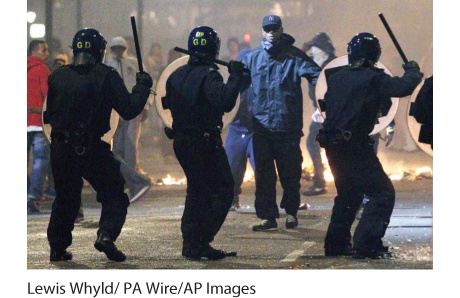Deindividuation

Deindividuation During England’s 2011 riots and looting, rioters were disinhibited by social arousal and by the anonymity provided by darkness and their hoods and masks. Later, some of those arrested expressed bewilderment over their own behavior.
We’ve seen that the presence of others can arouse people (social facilitation), or it can diminish their feelings of responsibility (social loafing). But sometimes the presence of others does both. The uninhibited behavior that results can range from a food fight to vandalism or rioting. Perhaps you can recall following the crowd in yelling at a referee or opposing team? This process of losing self-awareness and self-restraint, called deindividuation, often occurs when group participation makes people both aroused and anonymous. Compared with identifiable women in a control group, New York University women dressed in depersonalizing Ku Klux Klan–style hoods delivered twice as much presumed electric shock to a victim (Zimbardo, 1970).
Deindividuation thrives, for better or for worse, in many settings. The anonymity of online discussion boards and blog comment sections can unleash mocking or cruel words. Online bullies, who would never say “You’re the ugliest person I know” to someone’s face, will hide behind their anonymity. Tribal warriors who depersonalize themselves with face paints or masks are more likely than those with exposed faces to kill, torture, or mutilate captured enemies (Watson, 1973). When we shed self-awareness and self-restraint—whether in a mob, at a rock concert, at a ballgame, or at worship—we become more responsive to the group experience—bad or good. For a comparison of social facilitation, social loafing, and deindividuation, see Table 76.2.
| Phenomenon | Social context | Psychological effect of others’ presence | Behavioral effect |
|---|---|---|---|
| Social facilitation | Individual being observed | Increased arousal | Amplified dominant behavior, such as doing better what one does well (or doing worse what is difficult) |
| Social loafing | Group projects | Diminished feelings of responsibility when not individually accountable | Decreased effort |
| Deindividuation | Group setting that fosters arousal and anonymity | Reduced self-awareness | Lowered self-restraint |
* * *
We have examined the conditions under which the presence of others can motivate people to exert themselves or tempt them to free ride on the efforts of others, make easy tasks easier and difficult tasks harder, and enhance humor or fuel mob violence. Research also shows that interacting with others can similarly have both bad and good effects.